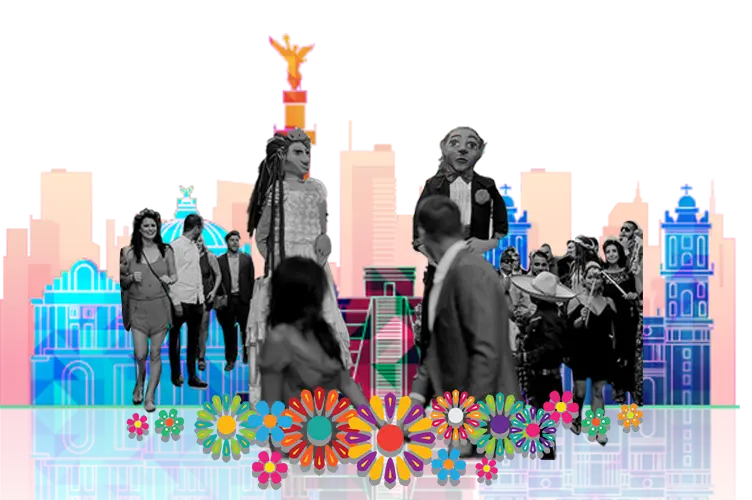
Mexican wedding traditions are as beautiful and spiritual as the Mexican culture overall. From wedding sponsors to traditional Mexican wedding cake necessities, here are some of our favorite Mexican wedding traditions you need to know about.
Padrinos and madrinas are wedding sponsors, or wedding godparents. Typically, the padrinos and madrinas are married and have watched the bride or groom grow up. You can have multiple madrinas and padrinos, and it’s certainly not uncommon for couples to have two to four sets.
On top of giving advice and guidance, a Mexican wedding’s padrinos and madrinas also make financial contributions to the ceremony.
Some things they might pay for might include:
The wedding lasso symbolizes unity, and in traditional Mexican weddings, the unity ceremony is performed right after the couple exchanges vows. The madrinas and padrinos place the wedding lasso over the couple’s shoulders in a figure-eight or infinity shape, representing a new beginning.
This el lazo can be a silk cord, flower garland, or an oversized rosary. It is almost always joined together in the middle by a crucifix. Once the lasso is placed, it’s typically followed by a prayer to bless the union. Then, at the end of the ceremony, the lasso is removed and kept as a memento.

Las arras matrimoniales is a collection of 13 coins. After the blessing and exchanging of rings, the priest will bless the 13 coins. Then, the groom will present them to the bride as a symbol of his commitment to provide for her and their home.
After the bride and groom exchange their vows and rings, the padrinos will bring forth a white Bible and a rosary, and place it in the hands of the couple. While they are holding it, the officiant will bless the bible.
A key element in Catholic wedding ceremonies and Mexican culture is the presentation of a bouquet to the Virgin Mary, the mother of Jesus. During this presentation, the couple will pray to the Virgin Mary and ask for her intercession in their union.

La Callejoneada is a regional mexican wedding tradition, a wedding parade in the streets, following the wedding ceremony. The couple and their guests will go through town, singing and dancing with a mariachi band and taking tequila shots.

The menus at Mexican wedding receptions will often include familiar favorites, such as:
There is often a wide variety in what’s offered, including multiple types of meat and sauces, allowing guests to customize their plates.
You’ll also see lots of local Mexican beers and tequilas on the bar menu, as well as fresh margaritas and a non-alcoholic option, such as agua fresca, in flavors like horchata and tamarind.
Polvorones or Mexican wedding cookies are two popular dessert options. A tres leches cake, buñueloas, or pan dulce are some other fantastic traditional Mexican desserts you’ll see.
The first dance of the night is always the couple’s first dance, and then, at some point in the evening, there is a dance known as la vibora de la mar, or the sea snake dance.
During this dance, guests hold onto each other and move about the dance floor before snaking under an arch formed by the newly-married couples’ hands. This dance is also sometimes known as the money dance.
La tornaboda is an after-party planned for the day following the reception, for the couples’ closest friends and family. It’s normally hosted by the bride or grooms’ parents.
On the wedding day, guests should wear clothes appropriate for a church ceremony. If you’re wearing a dress, make sure it covers your shoulders, and the hem falls at or below the knees; if you’re wearing a suit, make sure your slacks fit and match a clean, collared shirt and tie.
Mexican wedding receptions are more casual than the wedding ceremony, so staying dressed up for the post-ceremony celebration isn’t necessary. Some attendees may wear a guayabera (a linen button-down shirt with short sleeves). However, it’s tradition for the bride to pair a mantilla (a Spanish veil with an intricate lace border) with a traditional Mexican wedding dress, while the groom is in a formal suit.
Historically, the padrinos and madrinas would cover most of the wedding expenses. In more modern Mexican culture, the couples’ parents may contribute to the budget.
Due to a long list of Mexican wedding reception traditions, the normal Mexican wedding reception can last up to two days. While the actual wedding ceremony lasts around an hour, it’s not uncommon for the reception to be an all-day affair, sometimes even a two-day affair.
One of the silliest and showy Mexican wedding traditions is a so-called el muertito. During the reception, the male guests will lift the groom over their shoulders and toss him several times into the air. They usually take off his shoes and the guests put money and gifts into them.
Traditionally, the groom will pay for his bride’s wedding dress and is supposed to give the money to the bride’s family to make the attire themselves. The traditional Mexican wedding dress is supposed to incorporate elements of traditional Spanish attires, meaning lots of lace, beading, and multiple fabrics.
In conclusion, Mexican wedding traditions are stunning and filled with meaning and love that are celebrated with dancing, singing, prayer, and tons of ceremonies strong in culture. If you want to know more about culture-driven weddings like German, Korean, or Jewish–read about them all and more on our site, The Groom Club.